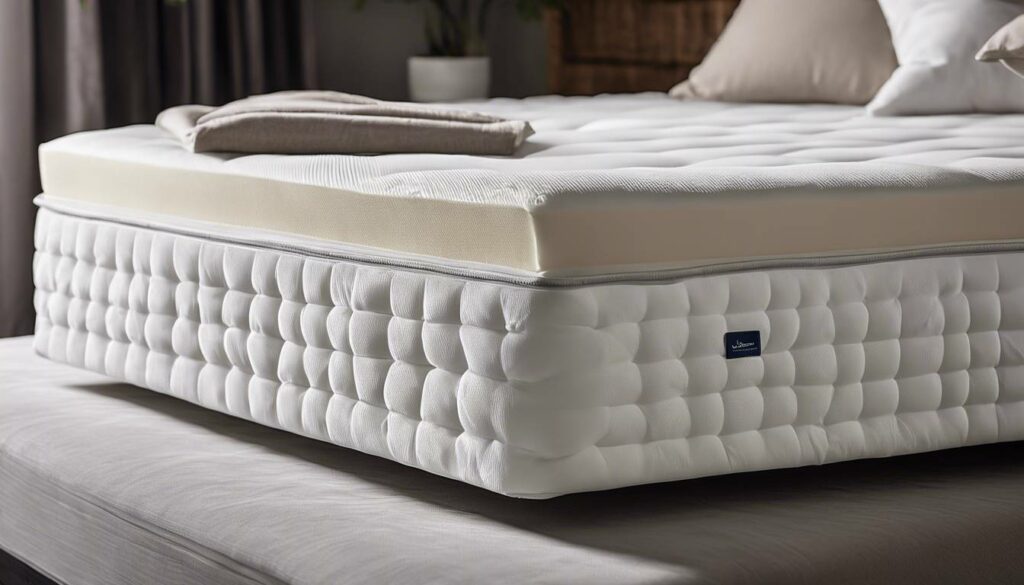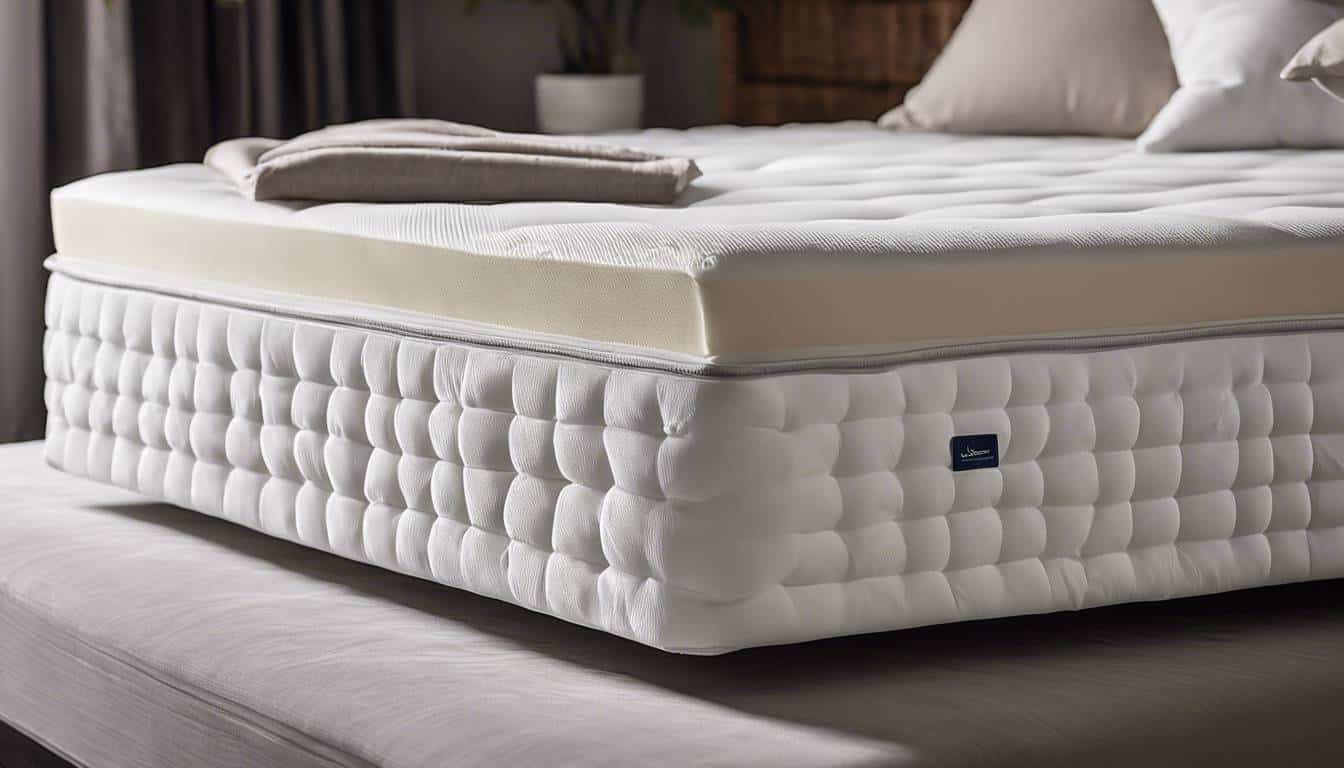I can go camping in the wilderness and spiders, ants and bugs don’t really phase me. Bed bugs however? Yikes. Those scare the CRAP out of me. So yes, bed bugs can call memory foam mattresses home. Their documented ventures include slipping into the smallest gaps, crevices, even burrowing into the covers of these comfortable sleeping surfaces. But it’s not all doom – there is a silver lining with proper knowledge and prevention techniques. We have a line of defence against these pesky critters. But more on that as we dive deeper.
While it’s possible for bed bugs to infest memory foam mattresses by hiding in crevices and seams, their dense structure makes it more challenging for bed bugs to penetrate deeply into the core. It’s crucial to regularly inspect your mattress and use mattress encasements as a preventive measure against bed bug infestation. This proactive approach can significantly reduce the risk of an infestation taking hold.
Can Bed Bugs Live in Memory Foam Mattresses?
The persistence of bed bugs has been a topic of concern for many, and rightly so. These pesky pests have adapted to various environments and have proven that they can infest numerous materials, including memory foam mattresses. The dense structure of memory foam poses a challenge for bed bugs to penetrate deep into the core, but it doesn’t deter them entirely. The small crevices and folds on the surface, as well as the seams and covers, provide perfect hiding spots for these unwelcome intruders. This is why even memory foam mattresses are not immune to bed bug infestations.
One may wonder how exactly bed bugs survive in a memory foam mattress. Well, bed bugs are resilient creatures, able to withstand a wide range of temperatures and conditions. They adapt to their surroundings and can find ways to thrive even in seemingly inhospitable environments. In a memory foam mattress, they can hide, lay eggs, and feed on unsuspecting sleepers without being noticed due to the mattress’s dense composition. This resilience makes choosing the right mattress crucial in preventing infestations.
When inspecting a memory foam mattress for bed bugs, it’s important to look for visual signs such as rust-colored bugs, molted skins, or black fecal spots. These indicators can help in identifying an infestation. Using a flashlight to closely examine the seams and checking beneath the mattress can reveal hidden colonies. It’s also essential to inspect bedding for any signs of infestation. A simple yet effective method involves using a credit card to push out hiding bugs along the seams, making it easier to detect their presence.
Prevention Tips
It’s crucial for consumers to be proactive in preventing bed bug infestations in memory foam mattresses. One effective measure is using mattress encasements that cover the entire mattress, acting as a protective barrier against bed bugs. Regularly inspecting for bed bugs and promptly addressing any signs of an infestation is also key. Additionally, being cautious while traveling and avoiding bringing used or second-hand furniture into your home can significantly reduce the risk of introducing bed bugs.
Now that we’ve covered how bed bugs can live in memory foam mattresses and preventive measures, let’s explore methods for treating a memory foam mattress infested with these persistent pests.
Memory Foam Properties and Bed Bug Infestation
Memory foam mattresses are a popular choice for many, thanks to their cushioning and supportive properties. The very same attributes that make them comfortable for us, however, also create hiding spots for bed bugs. The dense structure of memory foam makes it harder for bed bugs to penetrate deep into the core, but it doesn’t mean they can’t find crevices elsewhere in the mattress to shelter and reproduce. This is why it’s important to know how to remove stains and maintain your mattress, as proper maintenance can help prevent infestations.
Expanding on this idea, while traditional coil mattresses have more open spaces and thus fewer hiding spots for bed bugs, memory foam mattresses have a denser construction with fewer air pockets, making it easier for the pests to find harborage within the material. The ability of bed bugs to hide in small crevices, seams, and covers makes it crucial for homeowners to take proactive measures to prevent and address infestations.
Regular inspection is key, as even though bed bugs may find it challenging to navigate the inner layers of memory foam, they can still lurk in the seams and folds on the surface. Therefore, visual inspections for rust-colored bugs or molted skins on the surface, along with using a flashlight to closely examine the seams, is necessary to detect an infestation early.
It’s similar to how despite having a strong exterior, a fortress might have cracks or crevices where invaders could potentially infiltrate. This highlights why vigilance is important when dealing with bed bugs in memory foam mattresses.
These properties make it crucial for homeowners to take proactive measures to prevent and address infestations, especially considering the difficulty of complete eradication once an infestation occurs.
Taking preventive measures such as using mattress encasements that cover the entire mattress, regularly inspecting for bed bugs, avoiding second-hand furniture, and being cautious while traveling can help minimize the risk of infestation.
Emphasizing the importance of vigilance and preventive strategies can effectively lower the likelihood of bed bug infestations in memory foam mattresses.
Comparing Mattress Materials for Bed Bug Resistance
Not all mattresses are equally resistant to bed bug infestations. Different materials offer different levels of protection from these unwanted pests. Let’s delve into some key factors that affect bed bug resistance across various types of mattresses.
Memory Foam
Memory foam mattresses have a moderate level of resistance to bed bugs due to their dense structure, which makes it harder for bed bugs to penetrate deep into the mattress core. However, the small crevices and folds on the surface, as well as in the seams and covers, provide hiding spots for these pests, making memory foam susceptible to infestations.
Latex
In comparison to memory foam, latex mattresses offer higher resistance to bed bugs. Their solid and non-porous structure creates fewer hiding spots for bed bugs, reducing the likelihood of infestations. This makes latex mattresses a better choice for those concerned about bed bug susceptibility.
Innerspring
In contrast, innerspring mattresses are more vulnerable to bed bug infestations due to their construction. The open spaces within the mattress can provide ample hiding spots for these pests, leading to potential infestations if not properly protected.
Hybrid (Memory Foam and Innerspring)
Hybrid mattresses, which combine both memory foam and innerspring components, offer a moderate level of resistance to bed bugs. While the memory foam portion may provide some protection, the presence of innerspring components increases the potential hiding spots for bed bugs.
It’s essential for consumers to consider the level of bed bug resistance offered by different mattress materials when making purchasing decisions. For instance, individuals living in areas with high bed bug prevalence may prioritize selecting a mattress material with higher resistance, such as latex or air mattresses. Proper assessment of these factors can help consumers make informed choices and reduce the risk of potential bed bug infestations in their sleeping environment.
By understanding the varying levels of bed bug resistance across different mattress materials, consumers can ensure that they make informed choices when purchasing new mattresses. It’s not just about comfort; it’s also about creating an environment that is less susceptible to unwelcome bed bug guests.
With a deeper understanding of mattress materials and their impact on bed bug resistance, let’s arm ourselves with proactive measures to prevent these pests from making a home in our memory foam mattresses.
Tips to Prevent Bed Bugs in Memory Foam Mattresses
Preventing bed bug infestations in memory foam mattresses is crucial for maintaining a clean and pest-free sleeping environment. Here are some actionable tips to keep those pesky bugs at bay.
Use Mattress Encasements
Mattress encasements act like protective armor for your mattress. They cover the entire mattress, sealing off hiding spots and preventing bed bugs from taking refuge within the fibers and seams. When selecting a mattress encasement, ensure that it’s specifically designed for bed bug protection and covers the entire mattress snugly.
The benefits of using mattress encasements extend beyond just preventing bed bugs; they also play a vital role in maintaining hygiene. A high-quality encasement not only repels bed bugs but also acts as a barrier against spills, dust mites, and allergens, prolonging the lifespan of your mattress while ensuring a healthier sleep environment.
Regular Inspection
Visual inspections play a key role in early detection of bed bugs. Make it a habit to conduct thorough visual inspections of your memory foam mattress on a regular basis. Look out for telltale signs such as rust-colored bugs, molted skins, or black fecal spots. Remember to check the seams and tufts closely, as bed bugs tend to favor these areas for hiding.
While inspecting your memory foam mattress, it’s important to have a structured approach. Use a flashlight to illuminate the seams and crevices, and employ a credit card to gently push out any hiding bugs along the stitching. Additionally, don’t overlook the bedding—inspect pillows, blankets, and sheets thoroughly to ensure comprehensive coverage.
Avoid Second-hand Mattresses
When it comes to memory foam mattresses, it’s best to steer clear of second-hand options. Purchasing second-hand mattresses may seem cost-effective but comes with an increased risk of bed bug infestations. Second-hand mattresses can harbor hidden bed bugs that are challenging to detect during the initial inspection.
It’s important to recognize that even if the exterior of the mattress appears clean, there could still be lurking pests within its layers. The potential savings from buying a used mattress pale in comparison to the cost and hassle of dealing with a full-blown bed bug infestation.
By implementing these preventive measures, you can significantly reduce the likelihood of bed bug infestations in your memory foam mattress, creating a safer and more sanitary sleeping environment for you and your family.
As we’ve seen the importance of preventive measures against bed bugs in memory foam mattresses, next we’ll explore effective strategies for exterminating these resilient pests from your sleeping sanctuary.
Exterminating Bed Bugs from Memory Foam Mattresses
Dealing with a bed bug infestation in your memory foam mattress can be daunting, but it’s essential to address the problem promptly and effectively to prevent it from spreading. Non-pesticide approaches such as heat or cold treatments are practical options for exterminating bed bugs from memory foam mattresses without resorting to chemical solutions. It’s also important to know how to clean your vacuum after dealing with bed bugs, as these pests can potentially infest cleaning equipment.
Heat treatments involve exposing the mattress to temperatures above 120°F (49°C) for an extended period, effectively killing both bed bugs and their eggs. This method is a proven way to eliminate bed bugs and is often used by professionals who have the specialized equipment to ensure the temperature reaches every part of the mattress, leaving no place for the resilient pests to hide.
On the other hand, cold treatments involve freezing the mattress at temperatures below 0°F (-18°C) for several days. While this method is effective, it may require professional-grade equipment and monitoring to ensure all bed bugs have been eradicated.
It’s important to be cautious when attempting heat or cold treatments on your own, as improper execution can lead to ineffective results, potentially allowing bed bugs to survive and reinfest the mattress.
Aside from non-pesticide approaches, using pesticides labeled for bed bugs is another option for exterminating these pests from memory foam mattresses. However, it’s crucial to ensure that the chosen pesticide is safe for mattresses and follows the manufacturer’s recommendations for application. Always read and follow the instructions carefully to safeguard yourself and others from exposure to harmful chemicals.
Seeking professional assistance is highly advisable, especially in severe infestation cases where bed bugs have deeply entrenched themselves within the mattress. Professional pest control specialists have the expertise, equipment, and access to commercial-grade treatments that can effectively eliminate bed bugs while ensuring the safety of your memory foam mattress.
By considering non-pesticide approaches such as heat or cold treatments, using safe pesticides labeled for bed bugs, and seeking professional help when needed, you can effectively combat a bed bug infestation in your memory foam mattress and restore peace and comfort to your home. It’s also crucial to be aware of potential hiding spots, such as bed bugs in your vacuum cleaner, to ensure a comprehensive eradication.
As we navigate through the labyrinth of battling these resilient pests, understanding the health risks associated with bed bugs becomes paramount. Let’s delve into this critical exploration.
Health Risks Associated with Bed Bugs
Bed bugs are not just a nuisance; they can also pose serious health risks. Let’s explore some of the potential health concerns that come with bed bug infestations. First off, allergic reactions are one of the most common problems faced by people dealing with bed bugs. In fact, about 70% of people may experience allergic reactions to bed bug bites. These reactions can range from mild irritation and itching to severe rashes and even anaphylactic reactions in extreme cases.
The common symptoms of bed bug bites include red, itchy welts on the skin where the bed bugs have bitten. These welts often appear in a line or cluster and can be quite uncomfortable. Furthermore, these bites can lead to secondary infections if not properly cared for, adding to the health risks associated with bed bugs.
A study found that around 30% of individuals who experienced bed bug infestations reported psychological distress as a result. The constant stress and anxiety brought on by knowing that these bugs are present in your home can take a significant toll on mental and emotional well-being.
Some individuals reported being unable to sleep properly, feeling paranoid, and experiencing other psychological side effects due to the presence of bed bugs in their living environment. This underscores the importance of not only addressing the physical health risks but also acknowledging the mental and emotional impact of a bed bug infestation.
Proactive prevention and timely extermination methods are crucial in mitigating these health risks associated with bed bugs. Maintaining a clean living environment, regularly inspecting for signs of bed bugs, and employing proper extermination methods are essential steps in ensuring that your home remains free from these pests and the associated health hazards.
It’s important to take these health risks seriously and be vigilant in preventing and addressing bed bug infestations promptly. By doing so, you can protect yourself and your loved ones from potential allergic reactions, skin irritations, and psychological distress related to bed bug infestations.
By staying vigilant and taking proactive measures, you can mitigate the health risks associated with bed bug infestations, creating a safer and more comfortable living environment for you and your family.






